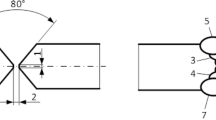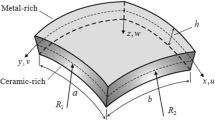Abstract
One of the interesting phenomenon in the study of fatigue crack propagation under variable amplitude load cycling is the crack growth retardation that normally occurs due to the application of a periodic overload. Fatigue crack growth rate under simple variable amplitude loading sequence incorporating period overloads is studied using single edge notched specimens of AISI304 stainless steel. Load interaction effects due to single and multiple overload have been addressed. Substantial retardation of fatigue crack growth rate is observed due to the introduction of periodic tensile overloads. Estimates of fatigue life have been obtained employing Wheeler model (using Paris and modified Paris equations) and Elber’s model. Analytical predictions are compared with experimental results. Results of these analytical fatigue life predictions show good agreement with the experimental fatigue life data. Fatigue crack propagation rates also have been evaluated from the fractographic study of fatigue striations seen on the fracture surface. Good agreement was found between the experimentally observed crack growth rates and the fatigue crack growth rates determined by the fractographic studies.
Similar content being viewed by others
Abbreviations
- a :
-
crack length
- a f :
-
final crack length
- ao :
-
initial crack length
- ao :
-
crack length before the overload
- ap :
-
sum of crack length before the OL and the OL plastic zone size
- C :
-
Paris constant
- C p :
-
Wheeler’s retardation coefficient
- da/dN :
-
fatigue crack growth rate
- f(g):
-
the geometric factor
- K c :
-
fracture toughness
- K max :
-
maximum stress intensity
- Kol :
-
stress intensity factor at the overload
- ΔK :
-
stress intensity factor range
- ΔKeff :
-
effective stress intensity factor
- m :
-
Paris coefficient (slope of crack growth curve)
- n :
-
number of cycles in the base constant amplitude cycle
- N :
-
total number of life cycles
- Lp :
-
number of crack propagation life cycle
- p :
-
Wheeler’s shaping exponent
- P :
-
applied load
- ΔP :
-
range of applied load
- Pmax :
-
maximum load applied in the cycle
- Pmean :
-
mean load of cycle
- P min :
-
minimum load applied in the cycle
- r y :
-
plastic zone size
- r OL :
-
overload plastic zone size
- R :
-
stress ratio
- t :
-
thickness of the specimen
- U :
-
effective stress parameter
- w :
-
width of the specimen
- p:
-
radius of the notch
- σ:
-
nominal stress at crack tip
- σalt :
-
mean stress at the crack tip
- σmax :
-
maximum stress at crack tip
- σmean :
-
mean stress at crack tip
- σmin :
-
minimum stress at crack tip
- σop :
-
crack opening stress
- σYS :
-
tensile yield strength of the material
References
H. Misawa, A. Fukushima, and Y. Kawakami, Effect of Very Small Number of Stress Cycles above Fatigue Limit on Fatigue Crack Propagation under Variable Amplitude Loading, Bull. Jpn. Soc. Mech. Eng., Vol 28 (No. 238–3), 1985, p 578–585
O. Vardar, Effect of Single Over Load in Fatigue Crack Propagation, Eng. Fract. Mech., Vol 30 (No. 3), 1988, p 329–335
Fatigue Reliability: Introduction, ASCE J. Structural Division, Vol 108 (No. 1), 1982, p 3–89
J.F. Knott and A.C. Picard, Effect of Over Load in Fatigue Crack Propagation: Aluminum Alloys, Metall. Sei., Aug/Sept 1977, p 399-421
W.J. Mills and R.W. Hertzberg, Load Interaction Effect on Fatigue Crack Propagation in 2024-T3 Aluminum Alloy, Eng. Fract. Mech., Vol 8, 1976, p 657–667
R.P. Wei and T.T. Shih, Delay in Fatigue Crack Growth, Int. J. Fatigue, Vol 10,1974, p 77–85
P.J. Bernard and C.E. Richards, Methods for Comparing Fatigue Lives for Spectrum Loading, Mater. Sei, 1977, p 390–398
K.T. Venkates wara Rao and R.O. Ritchie, Fatigue of Aluminum-Lithium Alloys, Int. Mater. Rev., Vol 37 (No. 4), 1992, p 153–185
O. Wheeler, Spectrum Loading and Crack Growth, J. ASME Trans., March 1972, p 181–186
J.J. Coner, J.A. Bannantine, and J. Handrock, Fundamentals of Metal Fatigue Analysis, Prentice Hall, 1990
L.P. Pook, Developments in Fracture Mechanics, Vol 1, Applied Science Publishers Ltd., 1983
R.J. Allen, A Review of Fatigue Crack Growth Characteristics by Linear Elastic Fracture Mechanics, Part III, Fatigue Fract. Eng. Mater. Struct., Vol 11 (No. 2), 1988, p 45–108
W. Elber, “The Significance of Crack Closure,” No. 486, ASTM STP, 1971, p 230–242
A. Gysler, N. Ohrloff, and G. Lutjering, Fatigue Crack Propagation Behavior under Variable Amplitude Loading, Fatigue Crack Propagation under Variable Amplitude Loading, J. Petit, D. Davidson, and P. Rabbe, Ed., Elsevier Science Publishers, 1988, p 24– 34
R.E.F. Jones, Fatigue Crack Growth Retardation after Single Cycle Peak Over Load in Ti-6A1-4V, Titanium Alloy, Eng. Mech., Vol 5, 1973, p 585–604
T. Shih and R.P. Wei, A Study of Crack Closure in Fatigue, Eng. Fract. Mech., Vol 6,1974, p 19–32
J.M. Barsom and S.T. Rolfe, Fracture and Fatigue Control in Structures: Application of Fracture Mechanics, 2nd ed., Prentice Hall, 1987
D.W. Hoeppner and W.E. Krupp, Prediction of Component Life by Application of Fatigue Crack Growth Knowledge, Eng. Fract. Mech., Vol 6, 1974, p 47–70
Author information
Authors and Affiliations
Rights and permissions
About this article
Cite this article
Khan, Z., Rauf, A. & Younas, M. Prediction of fatigue crack propagation life in notched members under variable amplitude loading. J. of Materi Eng and Perform 6, 365–373 (1997). https://doi.org/10.1007/s11665-997-0102-4
Issue Date:
DOI: https://doi.org/10.1007/s11665-997-0102-4




